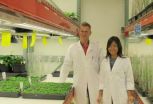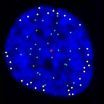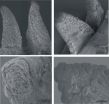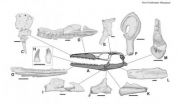Discovery may pave way to genetically enhanced biofuel crops
Plants engineered to have increased levels of beta-1,4-galactan may enhance biofuel production
2012-12-20
(Press-News.org) Best known for its ability to transform simmering pots of sugared fruit into marmalades and jams, pectin is a major constituent of plant cell walls and the middle lamella, the sticky layer that glues neighboring plant cells together. Pectin imparts strength and elasticity to the plant and forms a protective barrier against the environment. Several different kinds of pectic compounds combine to form pectin. The relative proportion of each of these depends on the plant species, location within the plant, and environment. Pectic compounds decorated with β-1,4-galactan (a chain of six-carbon sugars) are of considerable interest to the biofuels industry, because six-carbon sugars are readily converted into ethanol (biofuel) by fermenting microorganisms. A new study published in The Plant Cell reveals a novel enzyme involved in the production of β-1,4-galactans. This enzyme may be used to engineer plants with more desirable attributes for conversion to biofuel.
The major enzymes that catalyze pectin production are hard to pin down. Close to 70 enzymes are predicted to underlie pectin synthesis in plants; only about three of these have been identified definitively. Knowledge of these enzymes could be used to boost the production of pectins with desirable characteristics.
A team of researchers at the Joint BioEnergy Institute, University of California, Berkeley, and Technical University of Denmark set out to identify the enzymes that catalyze the production of β-1,4-galactan. They screened a database of enzymes for galactosyltransferases, the enzymes that link six-carbon galactose sugars into a chain. They found a family of proteins, named GT92, that are present in some animals and all plants sequenced to date. The authors found that mutations in each of the three genes encoding the GT92 proteins in the model plant Arabidopsis led to a reduction in β-1,4-galactan, whereas producing more of one of these proteins led to a 50% increase in β-1,4-galactan levels. In many cases, modifying the composition of plant cell wall components leads to alterations in growth or stature. Strikingly, all of the plant lines overproducing this important six-carbon sugar appeared to be healthy. Biochemical tests of the enzymatic properties of purified Arabidopsis GT92 protein supported the hypothesis that GT92 proteins are important enzymes for β-1,4-galactan synthesis in plants. This means that crops engineered to produce increased levels of GT92 proteins might contain more easily fermentable sugars, thereby potentially boosting the efficiency of biofuel production.
According to lead scientist Henrik Scheller, "Bioenergy crops with high β-1,4-galactan content would have significant advantages for the biofuels industry and we now have the knowledge to specifically increase β-1,4-galactan content in the biomass of cell walls. This breakthrough was made possible by a collaboration involving members of the Feedstocks Division at JBEI and our collaborators in Denmark. We are very excited about this result and look forward to testing it in a bioenergy crop such as switchgrass or poplar trees".
INFORMATION:
This research was supported by the Office of Science, Office of Biological and Environmental Research, the U. S. Department of Energy, and the Danish Strategic Research Council.
The research paper cited in this report is available at the following link:
http://www.plantcell.org/content/early/2012/12/14/tpc.112.106625.abstract
Liwanag, A.J.M., Ebert, B., Verhertbruggen, Y., Rennie, E.A., Rautengarten, C., Oikawa, A., Andersen, M.C.F., Clausen, M.H., and Scheller, H.V. (2012). Pectin Biosynthesis: GALS1 in Arabidopsis thaliana is a β-1,4-Galactan β-1,4-galactosyltransferase. Plant Cell 10.1105/tpc.112.106625.
The Plant Cell is published by the American Society of Plant Biologists. For more information about ASPB, please visit http://www.aspb.org/.
Restrictions: Use for noncommercial, educational purposes is granted without written permission. Please include a citation and acknowledge ASPB as copyright holder. For all other uses, contact diane@aspb.org.
[Attachments] See images for this press release:

ELSE PRESS RELEASES FROM THIS DATE:
2012-12-20
LA JOLLA, CA----For humans to grow and to replace and heal damaged tissues, the body's cells must continually reproduce, a process known as "cell division," by which one cell becomes two, two become four, and so on. A key question of biomedical research is how chromosomes, which are duplicated during cell division so that each daughter cell receives an exact copy of a person's genome, are arranged during this process.
Now, scientists at the Salk Institute have discovered a new characteristic of human cell division that may help explain how our DNA is organized in the ...
2012-12-20
Food enthusiasts interested in sustainable farm practices may soon have a new meat alternative: insects. Beetle larvae (called mealworms) farms produce more edible protein than traditional farms for chicken, pork, beef or milk, for the same amount of land used, according to research published December 19 in the open-access journal PLOS ONE by Dennis Oonincx and colleagues from the University of Wageningen, Netherlands.
The researchers compared the environmental impact of meat production on a mealworm farm to traditional animal farms using three parameters: Land usage, ...
2012-12-20
Prehistoric farming communities in Europe constructed water wells out of oak timbers, revealing that these first farmers were skilled carpenters long before metal was discovered or used for tools. The research published December 19 in the open access journal PLOS ONE by Willy Tegel and colleagues from the University of Freiburg, Germany, contradicts the common belief that metal tools were required to make complex wooden structures.
The wooden water wells discovered in eastern Germany are over 7000 years old, and suggest that these early farmers had unexpectedly refined ...
2012-12-20
Like sheets of paper marked with perforated lines, gecko tails have unique structural marks that help them sever their tails to make a quick getaway. Though voluntarily shedding a body part in this manner is a well-known phenomenon, research published December 19 in the open access journal PLOS ONE reveals aspects of the process that may have applications for structural engineers making similar, quickly detachable structures.
VIDEO:
Bridging structures are not present between ...
2012-12-20
Humpback whales might be expected to take their food seriously given their enormous size, but a new study shows that they may multi-task as they eat, singing mating or breeding songs as they forage in their Antarctic feeding grounds. The research, published December 19 in the open-access journal PLOS ONE by Alison Stimpert from the Naval Postgraduate School and colleagues, sheds new light on the whales' singing habits in different seasons, which are still a mystery.
Whales sing most frequently during the breeding season but are known to sing on other occasions, such as ...
2012-12-20
A new mosasaur species discovered in Hungary is the first known example of this group of scaled reptiles to have lived in freshwater river environments similar to modern freshwater dolphins, according to research published December 19 in the open-access journal PLOS ONE by Laszlo Makadi from the Hungarian Natural History Museum, Hungary and colleagues from the University of Alberta, Canada and MTA-ELTE Lendület Dinosaur Research Group, Hungary.
The species lived about 84 million years ago, the largest specimens reached about 20 feet in length, and belongs to a family ...
2012-12-20
LA JOLLA, Calif., December 19, 2012 – Amyotrophic lateral sclerosis (ALS), also known as Lou Gehrig's disease, is untreatable and fatal. Nerve cells in the spinal cord die, eventually taking away a person's ability to move or even breathe. A consortium of ALS researchers at multiple institutions, including Sanford-Burnham Medical Research Institute, Brigham and Women's Hospital, and the University of Massachusetts Medical School, tested transplanted neural stem cells as a treatment for the disease. In 11 independent studies, they found that transplanting neural stem cells ...
2012-12-20
From the stockings decorating mantles to the new outfits in display windows calling to shoppers, cotton is woven into the fabric of the holiday season. For bioenergy researchers, however, fiber composition matters more than color and texture as each cotton strand is composed of more than two dozen coils of cellulose, a target biomass for next-generation biofuels.
In the December 20, 2012 edition of Nature, an international consortium of researchers from 31 institutions including a team from the U.S. Department of Energy Joint Genome Institute (DOE JGI) present a high-quality ...
2012-12-20
Eating meals together as a family, even if only once or twice a week, increases children's daily fruit and vegetable intake to near the recommended 5 A Day, according to researchers at the University of Leeds.
The study of primary school-aged children, funded by the National Institute for Health Research Public Health Research (NIHR PHR) Programme, also suggests parental consumption of fruit and vegetables and cutting up portions of these foods boosted children's intake. It is published today in the British Medical Journal's Journal of Epidemiology & Community Health.
Overall, ...
2012-12-20
Globular clusters are spherical collections of stars, tightly bound to each other by their mutual gravity. Relics of the early years of the Universe, with ages of typically 12-13 billion years (the Big Bang took place 13.7 billion years ago), there are roughly 150 globular clusters in the Milky Way and they contain many of our galaxy's oldest stars.
But while the stars are old and the clusters formed in the distant past, astronomers using the MPG/ESO 2.2-metre telescope and the NASA/ESA Hubble Space Telescope have found that some of these clusters are still young at heart. ...
LAST 30 PRESS RELEASES:
[Press-News.org] Discovery may pave way to genetically enhanced biofuel crops
Plants engineered to have increased levels of beta-1,4-galactan may enhance biofuel production







